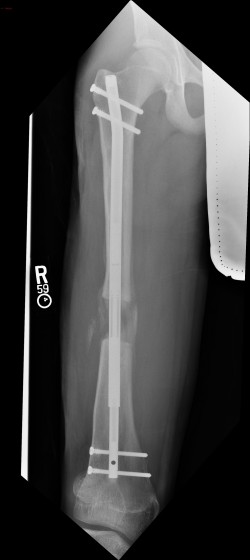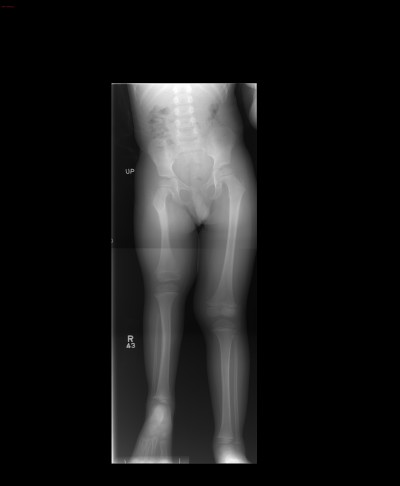At a Glance
- 14-year-old patient was the first at UVA to have the PRECICE Intramedullary Limb Lengthening procedure
- After the device is inserted, the patient extends the telescoping rod using a rotating magnet, gradually separating the bone
- The PRECICE Intramedullary Limb Lengthening System does not require an external brace or cast
- Device proves effective and less cumbersome than traditional external fixator
At UVA Children’s Hospital, orthopedic surgeons encounter a variety of congenital conditions that affect a child’s mobility. Some of these conditions are quite rare, so finding the right treatment option for each patient can be a challenge. Staying abreast of the latest technologies and procedures allows this team to provide patients with greater options — those that not only treat the underlying condition, but do so in a way that minimizes the impact on a child’s quality of life. Below is one example of an innovative procedure now being used to treat patients with congenital short femur.
Case Study: PRECICE® Intramedullary Limb Lengthening for Short Femur
Patient:
Jakeem Kirby, 14
Assessed by:
Pediatric orthopedic surgeon Mark Romness, MD
Diagnosis: Congenital short femur
At 6 months of age, Jakeem Kirby was referred by his pediatrician to UVA Health System after a checkup revealed his right leg was noticeably shorter than the left. The pediatric orthopedics team at UVA Children’s Hospital followed Jakeem closely over the next few years to determine which approach was best for him and to allow some growth in the size of his bone. By age 4, the length discrepancy was more pronounced. “At this point, his right leg was approximately 3 inches shorter than the left,” says orthopedic surgeon Mark Romness, MD. “By adulthood, the leg was predicted to be 6 inches to 8 inches shorter.”
Treatment: Gradual bone lengthening
Jakeem had multiple procedures over the years, including a procedure to straighten the femur at age 5. Efforts to lengthen the limb began at age 6 with an external fixator. This device is a frame that encircles the outside of the leg, with thin wires and thick pins that enter the skin and hold the severed bone in place as it is gradually separated and new bone regenerates to fill the void.
“When Jakeem had the fixator, he had to be home-schooled. Teachers and physical therapists came to the house and I had to stay home with him,” says Jakeem’s mom, Tiffany Kirby, of Danville, Va. “It was rough; it was painful for him when I turned the pins, and because the rods went through the skin, I had to keep it clean to prevent infection. And the fixator was so big and bulky, it put holes in the furniture.”
After approximately eight months with the external fixator, the femur was lengthened approximately 2 inches, but Jakeem’s right leg was still not as long as his left. “Lengthening the bone more than 15 percent at a time leads to many more complications, such as joint contractures in the leg, healing problems and poor bone formation,” says Romness. “So in severe cases, the lengthening is staged with time in between to recover joint range, muscle strength and bone density.”
When Jakeem turned 14, Romness recommended a new lengthening procedure: the PRECICE® Intramedullary Limb Lengthening System. Jakeem would be the first patient to have the procedure at UVA. “Jakeem was a good candidate because he had had bone lengthening procedures in the past, so he knew what to expect,” says Romness. “He also had great support at home from his mom.”
“When Dr. Romness first told us about the new procedure, I didn’t want to try it,” admits Tiffany Kirby. “I was just tired of so many procedures. But I trusted his judgment; he’s a good doctor, so I had no doubts that it was the right thing to do.”
Procedure: PRECICE® Nail insertion
 The PRECICE Intramedullary Limb Lengthening system consists of a telescoping intramedullary nail with three gear clusters connected to a magnetic spindle. This spindle turns a screw to expand or contract the nail; it is controlled by an external remote control (ERC) with two rotating magnets.
The PRECICE Intramedullary Limb Lengthening system consists of a telescoping intramedullary nail with three gear clusters connected to a magnetic spindle. This spindle turns a screw to expand or contract the nail; it is controlled by an external remote control (ERC) with two rotating magnets.
To insert the PRECICE nail, Romness made two small incisions on the right leg, one to insert the rod and another to cut the bone. The femur was cut and the nail was inserted into the bone’s marrow cavity. The rod was then attached to the upper and lower ends of the femur with transfixion blots through the bone and rod. A test run of the distraction or surgical bone lengthening was done with the ERC in the operating room to confirm proper movement of the two bone pieces. Because of the strength of the rod, no external support such as a cast or brace was needed.
After years spent compensating for his uneven gait, Jakeem developed a tight ankle and could not stand flat on his foot. Romness did a heel cord lengthening along with this procedure to bring the foot up and help resolve that issue.
“The surgery for the PRECICE nail is a little painful, but the patient typically leaves the hospital the next day and they are mobile within a few days,” says Romness. “The advantage of this technique is that everything is implanted; there are no bandages or anything external because there is an internal rod supporting the leg. There are no pins through the skin, which can get infected and cause discomfort.”
After a week of rest and healing, Jakeem began utilizing the ERC to initiate gradual bone separation. Three times per day, Jakeem placed the magnetic device on top of his leg.
“I showed him how to use the control the first time, but after that, he did it on his own,” says Kirby. “That was a relief and it made him feel good too.”
Each “magnet” session extends the nail 1/3mm for a total of 1mm per day of separation. “You have to extend the bone slowly so that muscle and tissues can keep up,” says Romness. “If you go too fast, these tissues get tight and can lead to injury. If you go too slow, the bone heals before you can pull it apart.”
Outcome: Successful leg lengthening
Now approximately two months out from the PRECICE Nail procedure, Jakeem visits UVA every two weeks for evaluation and imaging that allows Romness to monitor the progress of the lengthening and the quality of the bone growth. Jakeem also has physical therapy near his home three days per week to strengthen his leg.
“This is likely Jakeem’s last major procedure,” says Romness. “His legs will be almost equal in length once this one is done. Rod removal is not required, but he may consider that after one to two years, when the bone is well healed.”
Compared to the external fixator, this lengthening device has been much easier for Jakeem to manage, and it’s had a significant impact on both his physical and emotional well-being, says Kirby. “Before this procedure, he didn’t want to go out of the house with me because everyone would look at him. Now he’s happy as can be. He’s up and running around and he can wear regular clothes,” she says. “Hopefully this is his last procedure — we’ll just take it one day at a time.”
If you would like to learn more about the UVA pediatric orthopedic surgery team, please contact our Physician Relations team at 434.243.2733 to schedule a visit from one of our providers.
To refer a patient, call UVA Physician Direct at 800.552.3723.
